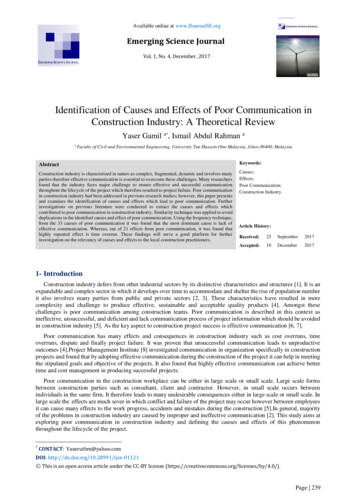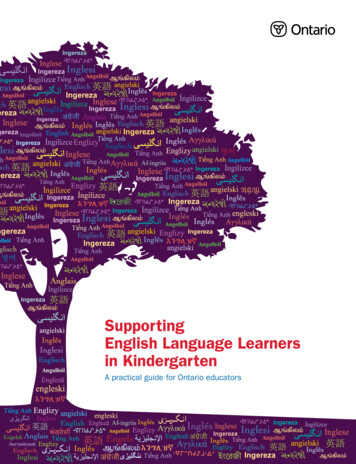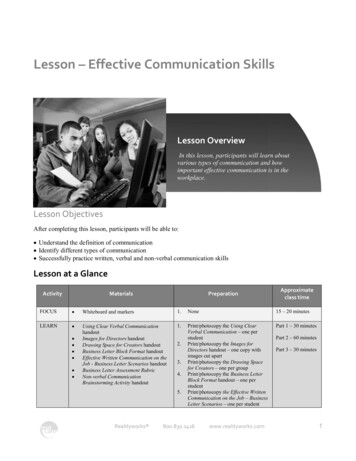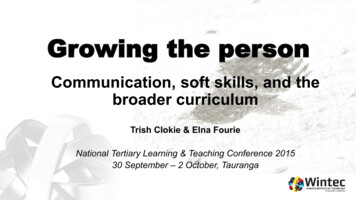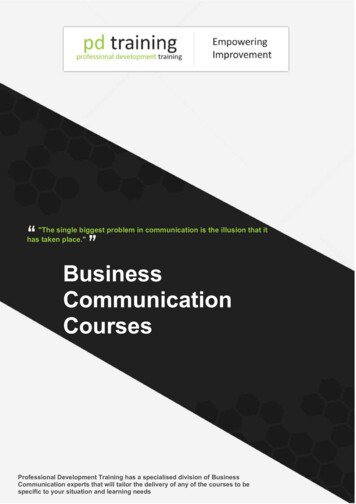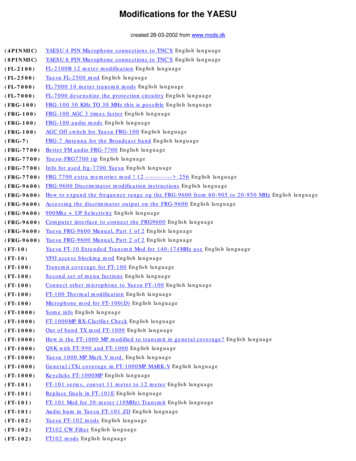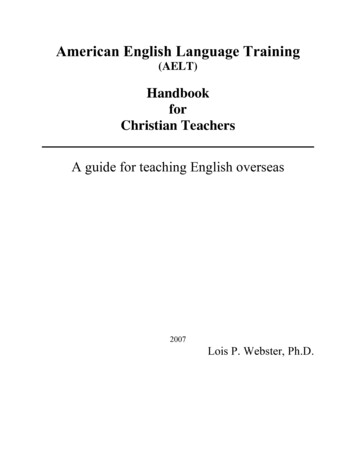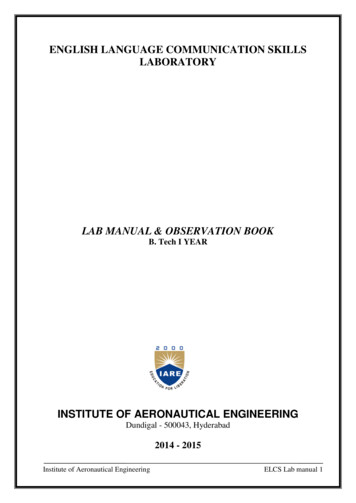
Transcription
ENGLISH LANGUAGE COMMUNICATION SKILLSLABORATORYLAB MANUAL & OBSERVATION BOOKB. Tech I YEARINSTITUTE OF AERONAUTICAL ENGINEERINGDundigal - 500043, Hyderabad2014 - 2015Institute of Aeronautical EngineeringELCS Lab manual 1
Institute of Aeronautical EngineeringELCS Lab manual 2
DEPARTMENT OF FRESHMAN ENGINEERINGEvaluation PatternThe English Language Communication Skills Laboratory can be broadly classified into two:i)Computer Assisted Language Labii)Interactive Communication Skills LabInternal Assessment: 25 Marks1)2)3)4)5)6)Two Internals will be conducted for Lab assessment.Students are advised to maintain a Record book to make a note of the activities donein the lab. 5 marks will be awarded for the same.Attendance will be taken regularly for the lab sessions for which 5 marks will beawarded.A written test for 10 marks will be conducted.Students are evaluated for 5 marks for activity.Total number of marks for Internal assessment is 25.External Examination: 50 Marks1) External assessment is based on a 3 hour examination process.Evaluation Pattern Theory- 20 MarksActivity- 10 MarksViva Voce- 20 MarksInstitute of Aeronautical EngineeringELCS Lab manual 3
LIST OF EXERCISES1.CALLLabICSLab2.4.Ice Breaking Activity and JAM SessionArticles, Prepositions, Word Formation-Prefixes &suffixes, Synonyms & Antonyms11- 2324- 33CALLLabMinimal Pairs- Word Accent and Stress Shifts- ListeningComprehension.47- 52ICSLabDescriptions- Narrations- Giving directions and guidelinesSequence of Tenses, Question Tags and One WordSubstitutes.53- 66Intonation and Common Errors in Pronunciation.67- 76Extempore- Public SpeakingActive and Passive Voice, Common Errors in English,Idioms and Phrases.77- 85Neutralization of Mother Tongue Influence andConversation Practice.86- 88Information Transfer- Oral Presentation SkillsReading Comprehension and Job Application with ResumePreparation.89- 109CALLLabICSLab5.1- 10Structure of Syllables- Past Tense Marker and PluralMarker- Weak forms and Strong forms- ConsonantClustersSituational Dialogues- Role Play- Expressions in varioussituations- Self introduction and introducing othersGreetings- Apologies- Requests- Social and ProfessionalEtiquette- Telephone EtiquetteConcord (Subject in agreement with Verb) and wordsoften misspelt- confused/misused.CALLLabICSLab3.Introduction to Phonetics- Speech Sounds- Vowels andConsonantsCALLLabICSLabInstitute of Aeronautical Engineering34- 46ELCS Lab manual 4
GENERAL INSTRUCTIONS1) Students are instructed not to use pen drives during lab sessions.2) Headphones should not be used for any other purpose except for listening to thesoftware.3) Students are required to be careful while handling and operating the computers.4) Students must bring their lab manuals to the lab without fail and get them signedby the faculty-in charge.5) Use of mobile phones during lab hours is strictly prohibited.6) Should Wear Formal Dress only.7) Should come to the lab in-time.8) It is mandatory to enter your name in log-in register.9) Should use the same system every time.10) Students are not allowed into the lab without ID Cards.11) All students should actively participate in the lab activities.12) Students are evaluated based on their active participation and proper behavior.Institute of Aeronautical EngineeringELCS Lab manual 5
INDEXS. No.DateName of the ExerciseInstitute of Aeronautical EngineeringGrade/Marks (5)SignatureELCS Lab manual 6
INDEXS. NoDateName of the ExerciseInstitute of Aeronautical EngineeringGrade/Marks(5)SignatureELCS Lab manual 7
EXERCISE-ICALL LABINTRODUCTION TO PHONETICSA. Objectives To identify speech sounds of English and their classification.To understand the concept of ‗neutralized accent and pronunciation‘.To know phonetic transcription and phonemic symbols of English.B. ContentWhy Phonetics need to be taught to technocrats?Firstly, with a large number of engineers and technologists going abroad, with aheavy expatriation of software Engineers to different countries like U.S.A., Australia,etc there is a need for these professionals to use effective communication skills. It is saidthat in the year 2002, 30,000 software engineers went to the U.S.A from the state of AndhraPradesh. During recent times, more number of students are going abroad for higher studieswith research prospects in fields like genetics, biotechnology, bio-informatics, etc. Whenthese students enter the classrooms abroad, the intelligibility between student and professorshould be given considerable importance.Secondly, with the emerging trends of telephonic interviews for selecting Engineersand professionals of different fields there is an emphasis on the verbal communication skills.Telephonic interviews provide little scope for non-verbal communication. In such a scenario,Spoken English plays a vital role for the success of these engineers and technologists.Lastly, with multinational companies (MNCs) setting their eyes on India as a longterm investment avenue, it is quite obvious that their major work force requirements have tobe met by the qualified Indian youth. Choosing to work for MNCs, where there is a higherprobability of interaction with people from different cultures and languages, one cannotremain complacent with one‘s minimal ability to use intelligible English. The jobopportunities outside one‘s region force one to get out of the region; this in turn necessitatesthe use of language in a manner intelligible to others (to those who do not belong to thatregion).Therefore it is important and imperative that the people involved in a social businesstransaction are intelligible to each other. It is noted that a host of these factors mentionedsuch as pronunciation, culture, and the context, come in the way of intelligibility. Thus,speech intelligibility would prove to be a fascinating area of study.Why should Phonetics be taught in Telangana and Andhra Pradesh?In Andhra Pradesh, English is considered as the language of the elite and fluency inEnglish is considered as a sign of culture and status in life. This is also one of the importantparameters that makes the youth employable. Proper pronunciation of English words wouldmake them global. Hence, there is every need to teach phonetics in Andhra Pradesh.Firstly, the sound system of Telugu is different from that of English. In English wehave 26 letters and these 26 letters produce 44 sounds. Whereas, Telugu has an equal numberof letters and sounds (56).Institute of Aeronautical EngineeringELCS Lab manual 8
Secondly, in English there is a mismatch between the spelling and the pronunciation.For instance the spelling ―ough‖ is pronounced in different ways, in words like ―through‖,―thorough‖, ―cough‖, etc. Whereas, in Telugu, we don‘t have any difficulty in pronouncingthe words because we read what we write.Thirdly, there are a few sounds in English that are absent in Telugu, example, thesound ‗Z‘ in zero is pronounced as /dz: r /. The sound / / in ―bank‖ is pronounced as /bja:nk/.Finally, unlike Telugu, we have many silent letters in English which are spelt, but notpronounced. Example: subtle, psychology etc.Phonetics: Phonetics is defined as ‗the scientific study of speech sounds.‘ It is a branch oflinguistics that deals with pronunciation. Every language has a set of sounds produced withthe air that we breathe out. Different sounds are produced with different parts of the mouth.The throat takes different positions and the air (breath) comes out through these positions.Phonology is the study of sounds within a language system.Organs of Speech: The organs that are involved in the production of speech sounds arecalled ―phonatory organs‖.A diagram showing the various speech organs or phonatory organs is displayed below:The various speech organs are described as follows:Alveolar ridge: It is also referred to as the (alveolar process) the teeth ridge. This inferiorlydirected ridge of the maxilla houses the upper teeth.Institute of Aeronautical EngineeringELCS Lab manual 9
Soft palate: The soft palate is also referred to as the velum. This musculo-tendious structureextends posterior from the hard palate and acts to modify the communication between theoral cavity below and nasal cavity above.Teeth: The teeth are embedded in the alveolar process of maxilla and mandible.Lips: The lips from the orifice of the mouth comprise of muscle fibres from a number ofdifferent facial muscles.Oral cavity: The oral cavity is also referred to as the mouth. It is a resonating chamberwhose shape is modified by articulation to produce the various oral and nasal speech sounds.Epiglottis: The epiglottis is a leaf shaped cartilaginous structure located behind the thyroidbone and at the root of the tongue.Vocal folds: Pair of vocal folds is located in the larynx, coursing from the thyroid cartilageinteriorly to the arytenoid cartilages. The vocal folds vibrate to create the sounds for vowels& voiced consonants.Pharynx: The pharynx is a resonating cavity or chamber lying above the hard & soft palate.Mandible: It is also known as the lower jaw. The mandible houses the lower teeth. Thetongue and lower tip also reside on the mandible.Hard palate: The hard palate forms the roof of the mouth along with the soft palate.Tongue blade: It is the part of the tongue lying just above the upper alveolar ridge.Tongue back: It is the part of the tongue lying below the soft palate.Tongue tip: (apex):- It is the part of the tongue lying closest to the front teeth.Mechanism of Sound production: When speech organs activate in a set pattern, the soundsare produced depending on the articulation. The sounds in English language are divided into2 types based on the position of vocal cords,1. Voiced 2. VoicelessThe Mechanism of ProductionConsonants: The consonants can be described based on their place of articulation, mannerof articulation and whether the sound is voiced or voiceless.1. Manner of articulation: Manner of articulation refers to how the sound is produced andthe way the air stream is modified as it passes through the vocal folds.It is of 6 types.a. Plosives: It is a consonant characterized by complete obstruction of the outgoing airstream by one of the articulators, a build of intra oral air pressure and a release.b. Fricatives: It is a consonant produced by forcing the breath stream through aconstruction formed by the articulators in the vocal folds.c. Affricates: It is a consonant characterized by having both Plosive and fricative mannersof production.d. Nasals: It refers to a consonant produced with a complete closure of the oral cavityalong with a lowered velum to allow air flow through the nasal cavity.e. Lateral: It is a genetic label used to classify two approximate English consonants /r/and /l/.f. Semi Vowels: It is a consonant characterized by a continuous gliding motion of thearticulators into the following vowel also referred to as semi-level /j/ and /w/.Institute of Aeronautical EngineeringELCS Lab manual 10
2. Place of articulation: Place of articulation refers to which articulators are involved in theproduction of a particular sound. These are divided into seven types.a. Bi-labial:-It refers to a speech sound, produced by the contact of the upper and lowerlips.b. Labio-dental: It is produced by the lower lip contacting the upper front teeth.c. Dental: It is produced by the tongue contacting the teeth.d. Alveolar: It refers to a consonant sound produced by the tongue contacting the upperalveolar ridge.e. Palato-alveolar: It is produced by the tongue contacting hard palate.f. Velar: It refers to a consonant produced by the tongue contacting the velum.g. Glottal: It is a place of articulation referring to a consonant that is produced bycompletely or partially contacting the glottis.Voice of articulation: Voicing refers to either vocal folds or their vibration during theproduction of a consonant. It is of two types.1) Voiced: A voiced sound is produced by the vibration of the abducted vocal folds in thelarynx.2) Voiceless: Voiceless sounds are produced without vibration of vocal folds.Three – term – labelsPlosivesExamples/p/Voiceless – bilabial – plosivePet,/b/Voiced – bilabial – plosiveBun, above/t/Voiceless – alveolar – plosiveTalk, active/d/Voiced – alveolar – plosiveDay, adopt/k/Voiceless – velar – plosiveKeeper, speaker/g/Voiced – velar – plosiveGoal, beginFricatives/f/Voiceless – labio – dental fricativeExamplesfit, before/v/Voiced – labio – dental fricativeVow, avoid/ /Voiceless – dental – fricativeThought, atheist/ /Voiced – dental – fricativeThese, weather/s/Voiceless – alveolar – fricativeSet, post/z/Voiced – alveolar – fricativeDesert, reason/ /Voiceless – palato-alveolar fricativeSheet, cash/ /Voiced – palato – alveolar fricativeProvision, occasionInstitute of Aeronautical EngineeringspillELCS Lab manual 11
Voiceless – glottal – fricative/h/Hay, behindAffricatesExamples/t /Voiceless – palato – alveolar affricateChop, latch/d /Voiced – palato – alveolar - affricateJew, jarNasalsExamples/m/Voiced – bilabial – nasalMan, calm/n/Voiced – alveolar – nasalNose, banal/ /Voiced – velar – nasalRing, singingSemi-vowels/j/ExamplesVoiced – unrounded – palatal semi- Yes, yesterdayvowel/w/Voiced – Rounded – labio – velarsemi – vowelWonder, widowLateralExamplesVoiced – alveolar – lateral/l/Frictionlesscontinuant/r/Live, calmExamplesVoiced post –alveolar – frictionless – Ground , greatcontinuantClassification of ConsonantsPlace Bilabial LabiodentalDentalManner Voiced- v.l.Voicele vdssv.l. sContinuantor Glide(Semivowel)pbAlveola Postralveolarv.l. vdvdtfv mwInstitute of Aeronautical Engineering snlPalato- Palatalalveolarv.l. vd vddVelarGlottalv.l. vdv.l.kt d zgh rj(w)ELCS Lab manual 12
Vowels: Vowel is a sound produced when there is no obstruction to the air stream anywherein the phonatory organs. A vowel sound is produced without friction. There are twelve (12)pure vowels and eight (8) diphthongs; total: twenty (20). Vowels are divided into twocategories based on the sound production. They are Monophthongs (pure vowels) andDiphthongs (vowel glides).Monophthongs: - Based on the part of the tongue raised and the extent to which the tongueis raised towards the palate, it is of three types:a) Front: - A front vowel is produced when the tongue moves forward from its neutralor rest position.b) Central: - A central vowel is produced with the tongue in its neutral position.c) Back: - Back vowels are produced by the backward shift of the tongue from itsneutral.MonophthongsExamplesClassification of tongue positions for vowels.Each, seaFront close unrounded1/i:/In, pitFront unrounded vowel between close and half-close2./I/Egg. FendFront unrounded vowel between half-close and half-open3./e/And, matFront unrounded vowel just below the half-open position4/ /Ask, flaskBack open unrounded5./a:/6.7.8.9.10.11.12./ // ://u//u:// //3:// /Off, lotAll, tallPull, sugarFood, stoolUp, funEarth, yearnSofa, alikeBack open unroundedBack rounded vowel between half-close and half-openBack rounded vowel between close and half-closeBack close rounded vowelCentral unrounded vowel between open and half-openCentral unrounded vowel between half-close and half-openCentral unrounded vowel between half-close and half-openDiphthongs: Diphthongs are two different vowels produced consecutively in the samesyllable moving articulation smoothly from their positions one after the other.Diphthongs consist of sounds such as:Sounds/ // // ////// /////ExamplesA glide from a front unrounded vowel just below half-close to a Ale, makecentralized front unrounded vowel just above half-close.A glide from a front – open unrounded vowel to a centralized from Ice, mikeunrounded vowel just above half-close.A glide from a back rounded vowel between open and half-open to a Oil, boycentralized front unrounded vowel just above the half-close position.A glide from the back open unrounded position and moves in the About, mouthdirection of RP. (u)A glide from a central unrounded vowel between half-close and half- No, oldopen to a centralized back rounded vowel just above the half-closeposition.A glide from a centralized front unrounded vowel just above half-close Serious,to a central unrounded vowel between half-close and half-open.periodA glide from the centralized back rounded vowel just above half-close Poor, cureto a central unrounded vowel between half-close and half-open.A glide from a front half-open unrounded vowel to a central unrounded Air, hairvowel between half-close and half-open.Institute of Aeronautical EngineeringELCS Lab manual 13
As you already know, phonetic symbols are a great help when it comes to learning topronounce English words correctly. Any time you open a dictionary, you can find the correctpronunciation of words you do not know by looking at the phonetic pronunciation that followsthe word. Unfortunately, learning the phonetic alphabet is not always the easiest thing to do.In English, as you know, many words can have the same pronunciation but are writtendifferently with different meanings. For example "to, two, and too" all have the phonetictranscription /tu/. Sometimes, words can be written similarly but have different pronunciationsas in the "ough" combinations in the words like thought, though,consonantsbough, and through.The IPA (International Phonetic Alphabet) chart is asfollows:VowelsIPA words/ / cup, luckIPA/ /wordsbad, lab/ /did, lady/ /find, if/ /give, flag/ /how, hello/ /yes, yellow/ /cat, back//leg, little/ /man, lemon/ /arm, father/ /cat, black/ /met, bed/ /away, cinema/ /turn, learn//hit, sitting/ /no, ten/ /see, heat/ /sing, finger/ /hot, rock/ /pet, map/ /call, four/ /red, try/ /put, could/ /sun, miss/ /blue, food/ /she, crash/ /five, eye/ /tea, getting/ /check, churchsay, eight/ /think, both/ go, home/ /this, mother/ /voice, five/ /wet, window/ /zoo, lazy/ /pleasure, vision// /// /// /// now, outboy, join/ where, airnear, here/ pure, tourist/Institute of Aeronautical Engineering/ just, largeELCS Lab manual 14
I.PRACTICE ACTIVITIESi) Fill the spaces with appropriate consonant sounds and then read the words aloud.1. Tap/ ǽ /2. Shut/ Λ /3. Budge/ Λ /4. Cross//5. Dose/ U /6. Sell/ e /7. Zoo/ u: /8. Possible/ I /9. Student/ u /10. Sure/ U /11. Rat/ ǽ /12. Beat/ i: /13. Busy/ i i: /14. Moss//15. Town/ U /16. Soar//17. Teak/ i: /18. Money/ Λ i: /19. Thanks/ θ ǽ /20. Yoke//ii) Fill in the spaces with appropriate vowel sounds and then read the words GateAgo/ f d // f t // t // s v n // m z // l // t r l // f n // d r // p s // p l // z b // l d // g t // g /Institute of Aeronautical EngineeringELCS Lab manual 15
Activity sheetInstitute of Aeronautical EngineeringELCS Lab manual 16
Activity sheetInstitute of Aeronautical EngineeringELCS Lab manual 17
ICS LABICE BREAKING ACTIVITY AND JAM SESSIONA. Objectives To give a quick start and initiation.To make students to start things on a pleasant note and think differentlyTo create interest among the students about a topic by exploring thoughts and ideasTo learn the use of body language and improve verbal messageTo gain experience in extemporaneous speaking or a prepared oral presentationTo understand the use of articles and prepositionsTo gain knowledge of word formation through usage of suffix, prefix, synonyms andantonyms.B. ContentIntroduction: Ice Breakers are an effective way of starting an interaction session or teambuilding event. They can be interactive and fun sessions, which run prior to the main event orday‘s activity. The activities can form a number of varieties including problem solving,facilitation, communication, leadership, team building, sharing and trust and decisionmaking.Ice breakers are particularly well suited for beginning a speech or starting a meeting.As the name implies, they ―break the ice,‖ help participants relax, and generally set the tonefor the presentation. They help to relax participants, and that makes them more receptive tolistening and contributing. An ice breaker can also serve to create a ―team atmosphere‖ andmotivate participants to work with others in a cooperative manner.Our Ice Breaker Activities are aimed at adding some energy and fun, allowing yourteam to think and look differently at how they can work together. Knowing when to insert anice breaker requires sensitivity and creativity. This will provide a unique opportunity for yourteam to develop new skills that can be critical for success in the workplace.In order to make ice breakers to be effective, it must employ Content, appropriate to the group,Appropriately timed,Should occur at the beginning, and then at appropriate times during the program.Lucky Penny: Each person takes a penny or other coin out of his/her pocket and looks at thedate. When it's his/her turn, s/he states the year that's on their coin and recalls somethingspectacular that happened that year.Categories - Have members of the group arrange themselves into groups by their favoritedessert, sport, color, movie, car, etc. This is a good activity to get people up and moving andto find out common likes. You can shift from one category to another. ―Now group byfavorite vacation spot.‖Stereotype Chat: Place a paper on each person's back with a characteristic on it (Valley Girl,Smart, Happy, Rich). Don't let them see what you are putting on them. Let the participantswander around and talk to each other, treating each other as they might treat someone withthat characteristic. Afterward have everyone guess what characteristic they had and tell howthey felt (good way to start a discussion on stereotypes or a cultural program).Institute of Aeronautical EngineeringELCS Lab manual 18
True or False: Participants say three things about themselves - two true and one false. Otherparticipants guess what the lie is. The correct guesser goes next.Know thyself: In this activity, the participants are asked to make a sincere attempt tosymbolize themselves in the form of a pictograph. For example: a flower for sensitivenessand a stone for hardness.JAM sessionIntroduction: Just a minute or JAM is an impromptu speech test conducted with the timelimit of one minute. As a student and as a budding technocrat, you will be asked to speak onthe spur of the moment to make a presentation. Right from a classroom situation where theinstructor would like to know what we have understood, to viva voce in the practicalexaminations, where your external examiner tests your domain knowledge, many situationswill demand you to make an impromptu speech.While many of us do not like to speak before people, there are times when we areasked to get up and say a few words about someone or a topic when we have not planned onsaying anything at all. We are more shocked than anyone else. Has this ever happened toyou? If and when this does happen to you, be prepared to rise to the challenge.The following two steps can be best used to master the art of giving an effective JAMsession:The first step is to go back to background knowledge and gather all the necessary ideasrelated to the topic given to you. Once you gather all the necessary ideas organize them in asequential order either chronologically or thematically. Then express them with clarity andcohesiveness.Three important rules to be followed in JAM are: No deviation No repetition No hesitationFor an effective JAM session 1. Be ready to speak in any given situation2. Utilize every opportunity as a suitable one to express yourself3. Authorize your ideas and stick to the topic4. Be creative and express new ideas5. Follow sequential order6. Be brief and to the point7. Maintain good flow of sentences8. Maintain good body language9. Be cautious of time10. Use positive and appropriate vocabulary.Topics for Jam sessions1.2.3.4.5.6.Bifurcation of states into smaller unitsIndia‘s money in Swiss BankBusiness ethicsStitch in time saves nineMoney saved is money earnedGrowing threat of global warmingInstitute of Aeronautical EngineeringELCS Lab manual 19
7. Inflation8. Depression among teenagers9. Impact of FDI on India10. Communication as a basic human need Use of Articles: Basically, an article is an adjective. Like adjectives, articles modifynouns.English has two articles:1. Definite article2. Indefinite article„The‟ is used to refer to specific or particular nouns; a/an is used to modify non-specific ornon-particular nouns. We call ‗the‟ the definite article and ‗a/ an‟ the indefinite articles.the definite articlea/ an indefinite articleFor example, if I say, "Let's read the book," I mean a specific book. If I say, "Let's read abook," I mean any book rather than a specific book.Here's another way to explain it: ‗The‟ is used to refer to a specific or particularmember of a group. For example, "I just saw the most popular movie of the year." There aremany movies, but only one particular movie is the most popular. Therefore, we use the."A/an" is used to refer to a non-specific or non-particular member of the group. Forexample, "I would like to go see a movie." Here, we're not talking about a specific movie.We're talking about any movie. There are many movies, and I want to see any movie. I don'thave a specific one in mind.Let's look at each kind of article a little more closely.Indefinite Articles: ‘a’ and ‘an’: "A" and "an" indicate that the noun modified is indefinite,referring to any member of a group. For example: "My daughter really wants a dog for Christmas." This refers to any dog."Somebody call a policeman!" This refers to any policeman. We don't need a specificpoliceman; we need any policeman who is available. "When I was at the zoo, I saw an elephant!" Here, we're talking about a single, nonspecific thing, in this case an elephant.Remember, using a or an depends on the sound that begins the next word. So, a singular noun beginning with a consonant: a boy; a car; a bike; a zoo; a dogan singular noun beginning with a vowel: an elephant; an egg; an apple; an idiot; anorphana singular noun beginning with a consonant sound: a user (sounds like 'yoo-zer,' i.e.begins with a consonant 'y' sound, so 'a' is used); a university; a unicyclean nouns starting with silent "h": an hour a nouns starting with a pronounced "h": a horse Institute of Aeronautical EngineeringELCS Lab manual 20
In some cases where "h" is pronounced, such as "historical," you can use an.However, a is more commonly used and preferred.Eg: A historical event is worth recording.Remember that these rules also apply when you use acronyms:Introductory Composition at Purdue (ICaP) handles first-year writing at the University.Therefore, an ICaP memo generally discusses issues concerning English 106 instructors.Another case where this rule applies is when acronyms start with consonant letters buthave vowel sounds:An MSDS (material safety data sheet) was used to record the data. An SPCC plan (SpillPrevention Control and Countermeasures plan) will help us prepare for the worst.If the noun is modified by an adjective, the choice between a and an depends on theinitial sound of the adjective that immediately follows the article: a broken eggan unusual problema European country (sounds like 'yer-o-pi-an,' i.e. begins with consonant 'y' sound)Remember, too, that in English, the indefinite articles are used to indicate membership in agroup: I am a teacher. (I am a member of a large group known as teachers.)Brian is an Irishman. (Brian is a member of the people known as Irish.)Seiko is a practicing Buddhist. (Seiko is a member of the group of people known asBuddhists.)Definite Article: “The”: The definite article is used before singular and plural nouns when thenoun is specific or particular. The signals that the noun is definite, that it refers to a particular memberof a group. For example:"The dog that bit me ran away." Here, we're talking about a specific dog, the dog that bit me."I was happy to see the policeman who saved my cat!" Here, we're talking about aparticular policeman. Even if we don't know the policeman's name, it's still a particularpoliceman because it is the one who saved the cat."I saw the elephant at the zoo." Here, we're talking about a specific noun. Probably there isonly one elephant at the zoo.Countable and Uncountable Nouns: The can be used with non-count nouns, or the articlecan be omitted entirely. "I love to sail over the water" (some specific body of water) or "I love to sail overwater" (any water). "He spilled the milk all over the floor" (some specific milk, perhaps the milk youbought earlier that day) or "He spilled milk all over the floor" (any milk)."A/an" can be used only with count nouns. "I need a bottle of water.""I need a new glass of milk."Institute of Aeronautical EngineeringELCS Lab manual 21
Most of the time, you can't say, "She wants a water," unless you're implying, say, a bottle ofwater.Geographical use of the: There are some specific rules for using „the‟ with geographical nouns.Do not use the before Names of most countries/territories: Italy, Mexico, Bolivia; however, the Netherlands,the Dominican Republic, the Philippines, the United StatesNames of cities, towns, or states: Seoul, Manitoba, MiamiNames of streets: Washington Blvd., Main St.names of lakes and bays: Lake Titicaca, Lake Erie except with a group of lakes like theGreat LakesNames of mountains: Mount Everest, Mount Fuji except with ranges of mountains likethe Andes or the Rockies or unusual names like the MatterhornNames of continents (Asia, Europe)Names of islands (Easter Island, Maui, Key West) except with island chains like theAleutians, the Hebrides, or the Canary IslandsDo use the before Names of rivers, o
The English Language Communication Skills Laboratory can be broadly classified into two: i) Computer Assisted Language Lab ii) Interactive Communication Skills Lab Internal Assessment: 25 Marks 1) Two Internals will be conducted for Lab assessment. 2) Students are advised to maintain a Record book to make a note of the activities done
